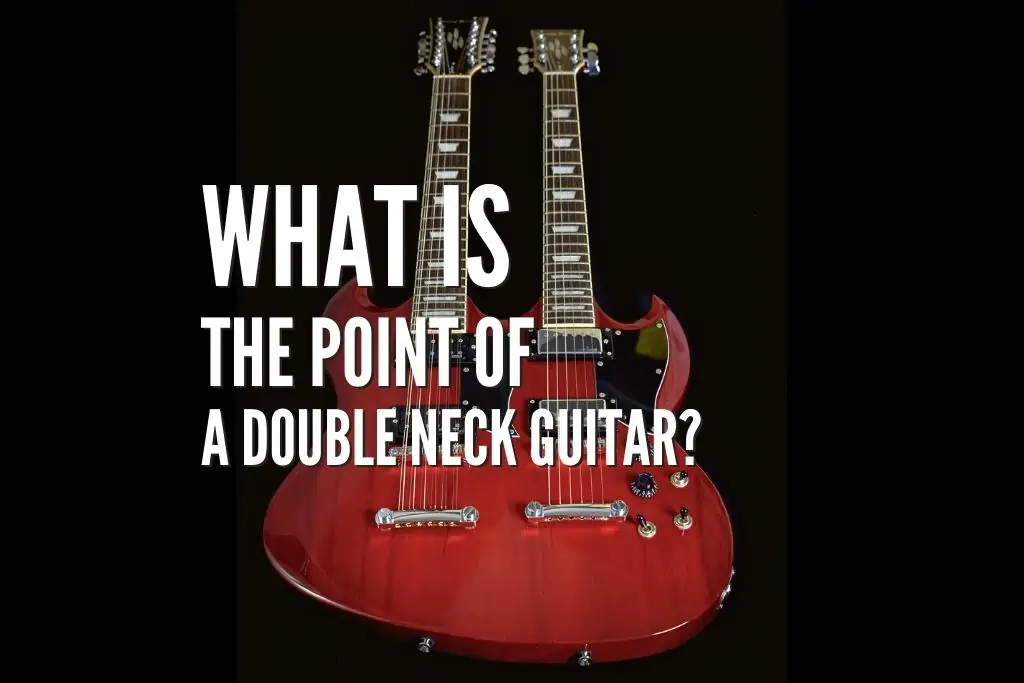When we were just starting as guitar players, many of us saw our guitar heroes playing those cool-looking double-neck guitars on TV and thought, man, that’s so cool. The wow factor of this guitar is undeniable. But in real life, the practicality can be in question.
So, what is the point of a double-neck guitar? It is the possibility to play two different guitars in the same song without the hassle of switching between them. For example, “Stairway to Heaven,” a song by Led Zeppelin, requires both a 12-string guitar and a 6-string guitar in a band with only one guitar player. A simple solution is a double-neck guitar, so Jimmy Page, the band’s guitarist, can easily switch between them whenever necessary.
There are many examples where this guitar is used. Of course, in a studio setting, there’s really no need for them. But in live playing, they can be pretty handy. And the wow factor of seeing that big guitar playing by a guitar god in a huge arena setting is something of a dream for the rest of us. But is this guitar really necessary, or can it be replaced with modern technology? Continue reading, and you’ll find out this and all the others facts you need to know about double-neck guitars.
What Are Pros And Cons Of Double-Neck Guitar?
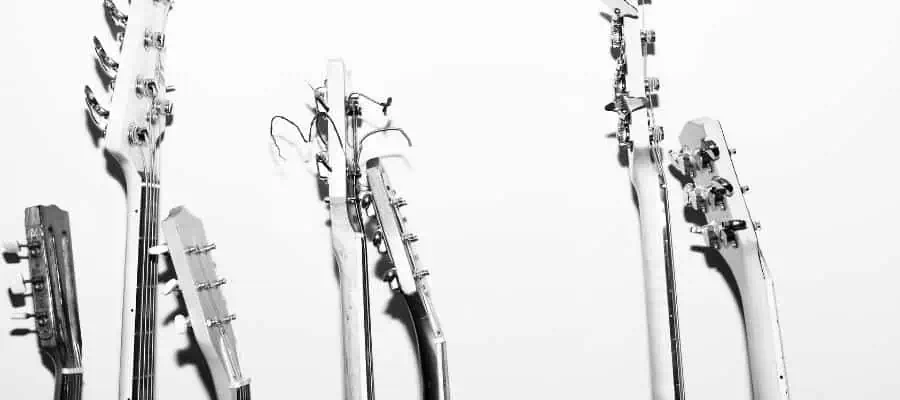
Pros
The double neck-guitars allow the users to play songs that require more than one guitar type, such as a 6-string electric guitar and a 12-string guitar, or a 6-string guitar and a 4-string bass. Any combination is possible with double-neck guitars.
There are many combinations of one-off double-neck instruments that can be a lifesaver in life-playing situations. With these guitars, you’ll be able to play both instruments in a song, back and forth, and not have to worry about constantly changing guitars, which is a logistical difficulty.
Then there are guitars, double-neck ones, 6-string electric, and a 6-string acoustic. A great thing to have, they have two outputs, one for electric that goes into your tube amp, and one for acoustic that goes directly into PA.
Double-neck can also have a 6-string guitar, a mandolin, or some other interesting instrument. This allows the player to explore various sonic spectrums within one song. It inspires you to come up with some new sound you weren’t even aware of. Here the possibility is endless.
One more advantage of a double-neck guitar is simply a wow factor. Many modern guitarists still use double-neck guitars in their live shows. When really there’s no need for them, either song doesn’t require one, or there is time and room to switch guitar. Nevertheless, playing one on stage is such a joy and privilege that many players choose to do it and will choose to do it in the future.
Cons
As I wrote, there are pros to using one. But there are many cons to these guitars. First of all, they are pretty expensive. The most famous is the Gibson EDS-1275, a variant of an SG standard that costs more than 6000$. A single-neck normal SG costs around 1800$. For the remaining money, you can buy a great 12-string guitar and some.
Another point is that a double-neck guitar is not necessary if you are not trying to play a song that needs a 6-string and a 12-string guitar. These guitars are rarely used because most songs don’t need them. Either there are no two different guitars used, or in most cases band has two or more guitar players that can cover all the needs.
Then the weight. Double-neck guitars are really heavy. The Gibson EDS1275 weight is around 13 lbs. That’s twice as heavy as a dreadnought acoustic guitar and at least 3-6 lbs heavier than a regular solid-body electric guitar, which most are around 7-9 lbs. This can be a huge downside. Having a 13 lb weight on your neck from the guitar strap is not desirable for a multi-hour gig. That’s probably the reason why they are only pulled out for certain songs.
The last thing, these guitars can be very confusing for a beginner to play. There is the reason we don’t see them that often on newbie youtube channels. The simple setup of this guitar is harder to do than on a normal guitar, and the hassle of changing the 18 or more strings on both necks is no joy either. No wonder we see them play by guitar gods with their own technicians doing setups and string changes for them. Simply put, these guitars are just not practical and necessary for the rest of us.
Are Double Neck Guitars Worth The Money?
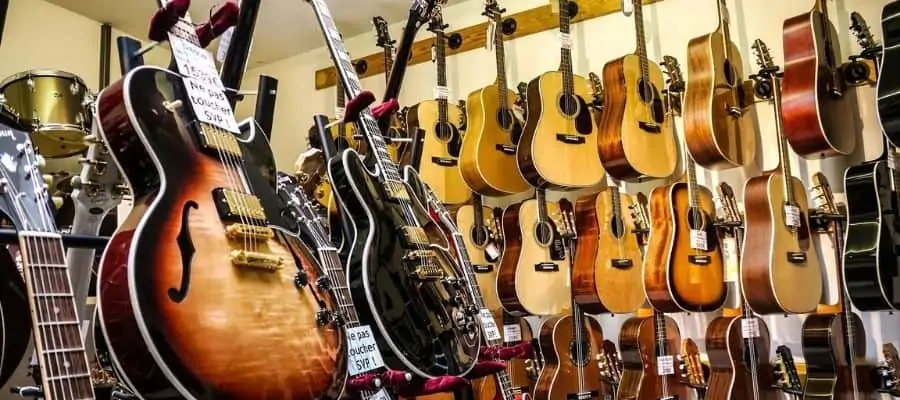
This is of the biggest questions people always ask about double-neck guitars. Are there actually worth the money? Double neck guitars are very expensive. Take the Gibson EDS-1275, for example. They are few and far between, but you can find second-hand models for around $3000. But a new model will set you back nearly $6000. For double-neck guitars, you will expect to pay around 3x what you would for the standard single-neck version.
But then again, it’s hard to say whether they’re worth the money or not. If you are the only guitarist in a band and you are playing covers, or your songs that sound better with a 6-string and 12-string or any kind of two guitar types attached to the same body, then the double-neck might be good for you. This way, you can perform your songs without the need to change them every now and then, and the double-neck guitar gets useful.
But you’d have to be a pretty good player for it to be worth it because if you’re like pretty much every other guitarist, you won’t ever need a double-neck guitar. Basically, every song ever written doesn’t require you to use one, so you’ll rarely, if ever, notice that it’s a problem not having one around.
So like I wrote earlier, double-neck guitars are just cool. They’re versatile, they’re powerful, and they just can make your presentation pop! But just like pyrotechnics and light shows, you have to use the explosions and light sparingly because, as with anything, it becomes balsamy if you overuse them. A kind of instrument like that will hold its shock or wow factor only if it’s used rarely and sparingly. Overusing them would diminish its mysticism and awesomeness.
Furthermore, it can be said that double-neck guitars don’t really add anything to the song but are just a gimmick to wow the crowd. This can be true if the potential of the double-neck is not reached.
If the player uses one neck the entire time and then plays the 12-string guitar or the mandolin or the bass just for one riff, then it’s not exactly worth the hassle of holding the thing for the whole show. But if it reaches its full potential, and it can, in the hands of Steve Vai or Michale Angelo Batio, then it’s worth the money.
In the old days, using these guitars was a real need. But with technology going forward, there is little necessity to use one. The sounds you achieve with a double-necked guitar can be achieved with digital help, such as with sophisticated effects pedals or with synthesizers.
So in the and are they worth the money. No, they aren’t. The good ones are pretty expensive. Yes, you can buy some imported generic ones for much less money, but their quality is really in question. They were and always will be just an addition to your guitar arsenal if you are a well-known rock star and have the money to afford one.
Who Are Most Famous Users Of Double Neck Guitars?

There are plenty of professional guitarists that have been seen with double-neck guitars. Many are from the glory days of these guitars of the 70s, 80s, and 90s. But many of them are from today’s guitar world, where let’s be honest, this guitar is more of a show of guitars than necessity. But here are some of the most famous users of double-neck guitars;
Don Felder – The Eagles

Alex Lifeson – Rush

Slash – Guns n’ Roses

Jimmy Page – Led Zeppelin

Matthew Bellamy – Muse

James Hetfield – Metallica

Rik Emmett – Triumph

Mike Rutherford – Genesis

Steve Vai

Michal Angelo Batio

Neil Schon – Journey

John Mclaughlin

Ian Thornley – Big Wreck

As you see from the list, one guitar god after another, the thrill of playing the double-neck for a well-established guitar player in the rock world is sort of a must. If only for a couple of songs during their artistic lifetime, but it’s hard to find a rock guitarist that never played one on stage.
What Are The Most Common Double Neck Guitars?
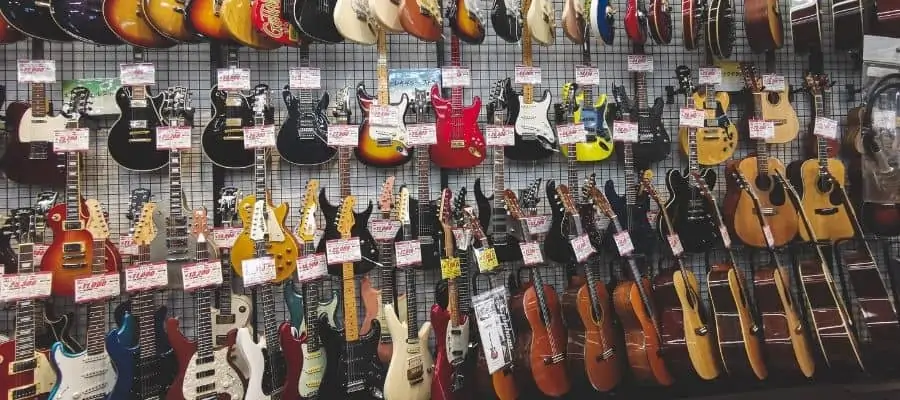
As I wrote, there are different versions of double-neck guitars; the possibilities are endless. Many boutique luthiers are making all sorts of combinations, too much to cover in this article. But here are the most common ones.
12-String and 6-String
This is the most famous double-neck combination. The 12-string guitar has a built-in chorus effect from 6 pairs of strings tuned to the same note an octave apart. This sound was really popular in many incredibly famous songs from the ’70s to the ’90s, including Bon Jovi’s Wanted Dead Or Alive, The Eagles’ Hotel California, and Led Zeppelin’s Stairway to Heaven, to name a few. If you listen to these songs, you can’t deny that the 12-string sound is important for the song.
It’s hard to imagine that you can perform these songs without that double-neck guitars. You can see how the two instruments are used for two different purposes. The song’s melody is played with a 12-string neck, but when it’s time to solo player jumps to the 6-string neck. This type of music is typical for this 12-6 string combination of double-necks.
6-String and 4-String Bass Combo
It’s not typical that a guitar player would play bass or vice versa. But this combination brings an incredibly versatile sound possibility. A bassist/guitarist can play a bass solo and then switch to a guitar solo in the same song. Some would argue that no good could come from such an arrangement, but that’s far from the truth.
The point is that a single player can now play two radically different instruments in a song at the flip of a switch. If skilled enough, the player can play the bass notes as a baseline for his guitar music. This is possible only for very skilled players, but it can be done.
Double-6 string necks
You may wonder what the purpose of that combination is? For most of us, 6 strings are plenty enough. Well, there are more skillful players in the world than most of us are. What a double-6-string guitar can do is give the ability for multiple tunings. Guitarists love multiple tunings as you can achieve a different feel and sound simply by changing the tuning.
For example, on one neck, you can have your standard tuning, and on another neck, you can have an open tuning for a slide guitar. Furthermore, the setup can vary. On your standard tuning neck, you can have nice low action so you can play easily, and on an open tuning neck, you can raise the action so it will apply well for the slide playing.
Another reason for playing a double-6-string neck can be really interesting. It’s the possibility for simultaneous play. It’s actually possible to play both necks of the guitar at the same time without plucking the strings but instead solely relying on hammer-ons and pull-offs.
One example is a player called Michael Angelo Batio. A really incredible player. Many of us know who he is; if you don’t, you better check him out. Not something you’ll see every day, but it is something that shows you the full potential of double-6-string neck guitars. And this talent really can’t be duplicated even with the use of modern effects. It’s pure human talent and a lot of hours put in.

There is one more thing closely related to simultaneous play. It is the Looping method. When you play the guitar, record your steps on a Looper Pedal. First, you play bass and drums sections followed by guitar lines. Justin Johnson is a prime example of this method.

Other Combinations of Double-Necks
The combos of these guitars don’t stop on the three mentioned. There are guitars that mix basses, 6-string guitars, 12-string guitars, mandolins, and even the banjo. All these combos bring versatility not possible with a single-neck guitar. As I wrote earlier, there are no limits to these instruments. It’s up to the imagination of a luthier or a player ordering one.
Multiple-neck guitars
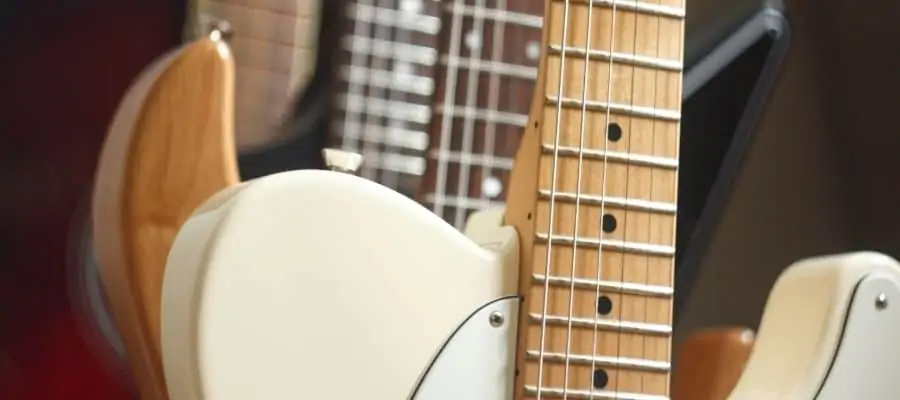
Beyond double-neck guitars, there are guitars, or should I say instruments, that sport 3 or more necks on them. There are many examples of these “weird” creatures—all of them eye-catchers. There are too many to be included here, but I’ll mention some of the most famous ones.
Steve Vai has the iconic Heart Guitar, which has three necks. The first one has 12 strings, and the other two both have 6 strings. The first 6-string neck has the face away from the player and features a different tuning and a capo. The other 6-string neck is quite classic with a traditional layout.
Another unique guitar of Steve Vai is made by Ibanez, again featuring a three-neck design including a 7-string and a 12-string electric guitar along with a 4-string ¾ scale bass. The guitar is called Hydra and comes equipped with 13 sympathetic harp strings, half-fretless fingerboards, humbucker, and single-coil pickups, as well as piezo, MIDI, sustainer pickups, hardtail and floating tremolo bridges, and splitters. It is a highly versatile beast.
Rick Nielsen is another name with a multi-neck guitar. His model, made by Hamer guitars, has five necks. On the other side, another guitarist, Boredoms’ Yamantaka Eye, has a gigantic guitar with seven necks.
The largest muli-necked string instrument in the world is the Rock Ock guitar, located in the National Guitar Museum. The guitar features 8 necks and weighs around 40 pounds. It has 51 strings, 154 frets, 8 necks including a mandolin, an ukulele, a traditional 6-string, a fretless bass, a standard bass, a 12-string guitar, and a 7-string guitar. The guitar was designed by noted artist Gerard Huerta and built by Dan Neafsey of DGN Custom Guitars.
What Are Most Famous Production Models Of Double Neck Guitars?
- Gibson EDS1275
- Guild Crossroads Doubleneck
- Dean GS
- B.C Rich Bich
- Gretsch Jet
- Kenneth Lawrence Explorer
- Gibson EMS 1235
Conclusion
Are double-necks necessary? Well no. But they are certainly desirable. I think there’s not a single one of us that didn’t want to play or own one at some point in life. These mythical creatures we see on stage worldwide are a guitar of desire.
Merely a few of us will become world-known rock stars and get to play one in some big stadium. Rest of us, if you get the opportunity to play one, do it. These guitars are hard to put in words. For some, they are pointless, unnecessary expensive nonsense. But you can’t deny their importance as a big piece of rock n’ roll history.
If you found this article useful, you may want to save this pin below to your Guitar board.

Recent Posts
Some guitarists insist on buying an expensive amplifier with their electric guitar. They assume that this is a must for every type of guitarist out there. However, in some situations, this isn’t...
Top 50 Free Realistic Guitar VST Plugins With Sound Examples
As technology has rapidly advanced in the recent decade, computers are stealing more and more roles from physical musical instruments and accessories. Nowadays, you do not need expensive amps,...

